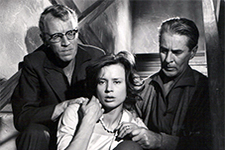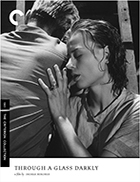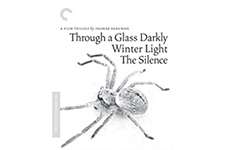Through a Glass Darkly (Såsom i en spegel)
|  Ingmar Bergman’s Through a Glass Darkly (Såsom i en spegel) marked a major shift in the Swedish auteur’s career, as it was the first of his “chamber films”—intense dramas featuring just a small handful of characters and usually set in a single location over a short period of time. Bergman had risen to international stardom during the previous decades with films of greater scope, including the romantic comedy Smiles of a Summer Night (1955) and the metaphysical drama The Seventh Seal (1957). The previous year he had won the Foreign Language Film Oscar for The Virgin Spring (1960), a medieval tale of violence and vengeance set against the backdrop of the cultural shift from paganism to Christianity. That film was also notable for being the first collaboration between Bergman and cinematographer Sven Nykvist, who would go on to shoot virtually all of his subsequent films (Bergman had collaborated with Gunnar Fischer on most of his film since the early 1950s). Bergman has described Through a Glass Darkly, which is the first of a loose trilogy (also included are 1963’s Winter Light and The Silence), as a “surreptitious play.” Bergman had long oscillated between film and theater, and he wrote the screenplay while he was simultaneously mounting a production of Anton Chekhov’s The Sea Gull at Dramaten (Sweden’s Royal Dramatic Theatre), of which he would later be the managing director from 1963 to 1966. Chekhov’s play proved enormously influential on Bergman’s thinking, particularly his use of a play-within-the-film that reveals important insight into the characters. More important, though, was Bergman’s decision to, in his words, “drop all artistic tricks and concentrate on the human drama.” And that is precisely what he does in Through a Glass Darkly, which is a spare, intense, introspective look at the interpersonal dynamics of a quartet of family members struggling with their own identities and their understanding of each other. We are simultaneously introduced to all of the characters as they emerge from the ocean after a morning swim. The oldest character, David (Gunnar Björnstrand), is a novelist whose success often keeps him away from his family for long periods of time. He is also, we will learn, an emotionally remote man who does not connect well with those around him, to the point that they question his capacity to care for others. David is vacationing at a seaside cottage (the film was shot on the rocky island of Fåro, where Bergman would eventually live) with his 17-year-old son Minus (Lars Passgård), an aspiring writer; his adult daughter Karin (Harriet Andersson), who is suffering from a schizophrenic disorder that is growing steadily worse; and Karin’s husband, a doctor named Martin (Max von Sydow). Karin, who is both full of life and on the edge of a complete mental breakdown, stands in the midst of these three men, each of whom has his own struggles. Minus is battling to form his own identity in David’s shadow and resents his father’s remoteness, yet desperately yearns for his love and guidance. Martin, on the other hand, is struggling with the knowledge that Karin’s condition will only get worse and is uncurable, something of which he has not made her aware. And David has been secretly making notes about Karin’s condition with the idea that he will use the material for his next novel, something about which he feels terribly guilty, but is compelled to do nonetheless. The story unfolds over a 24-hour period (from dawn to dawn), during which time each character will come to know him- or herself better while also being more fully revealed to the others. This means that much of the film consists of carefully balanced scenes of character interaction, often in pairs. Bergman and Nykvist employ a spare visual style that marked a significant departure from Bergman’s previous, more elaborately “cinematic” films. Nykvist’s adeptness at working with natural light corresponds with the dramatic realism, although there are moments when he and Bergman work in carefully designed and utterly striking compositions, such as the shot in which we see Karin’s open eye, bathed in light, staring out from behind the V formed by the neck and shoulder of Martin’s slumbering body. Most of the film is deliberately spare, though, which makes it feel even more like a play disguised as a film. The performances are uniformly good, although Lars Passgård, a recent drama school graduate, doesn’t quite measure up to the role of Minus (he feels like he’s struggling more than his character). Harriet Andersson, on the other hand, whom Bergman had cast in five of his early films and had been absent from the screen for years, delivers a searing performance. Mental illness can all too often be a lazy dramatic crutch (not to mention an excuse for all kinds of showy acting), but Andersson invests Karin with such vitality that the fear of its loss drives the film’s drama into deeper and darker territory. She is both sensual and spiritual, which is why she stands at the epicenter of the three men, acting as the glass through which they will eventually come to see themselves.
Copyright © 2019 James Kendrick Thoughts? E-mail James Kendrick All images copyright © The Criterion Collection | |||||||||||||||||||||||||||||||
Overall Rating: 


 (3.5)
(3.5)


 Through a Glass Darkly is available as part of The Criterion Collection’s “A Film Trilogy by Ingmar Bergman” boxset, which also includes Winter Light (1963) and The Silence (1963).
Through a Glass Darkly is available as part of The Criterion Collection’s “A Film Trilogy by Ingmar Bergman” boxset, which also includes Winter Light (1963) and The Silence (1963).